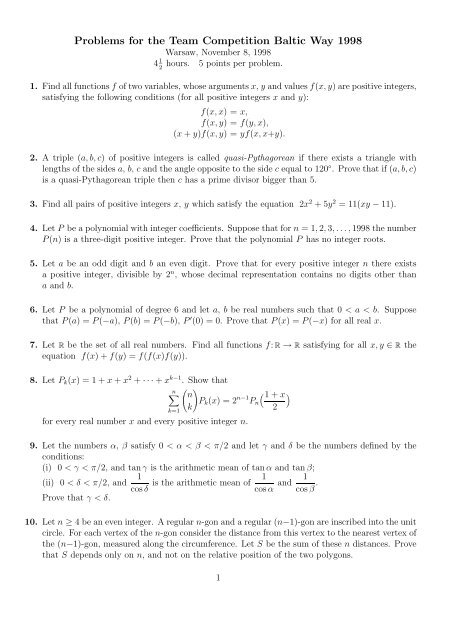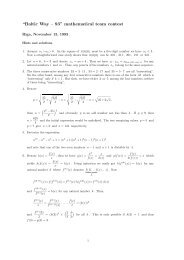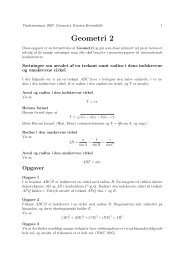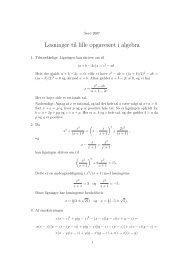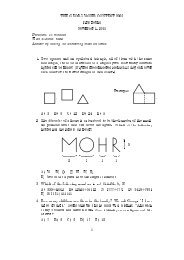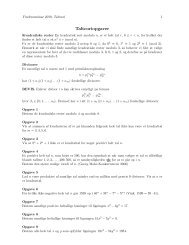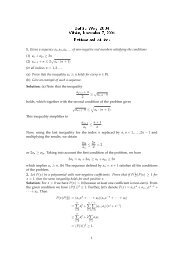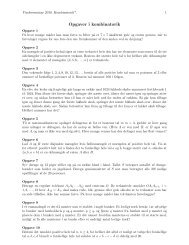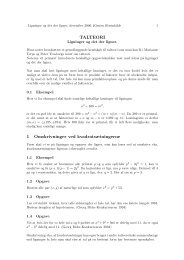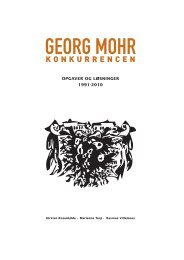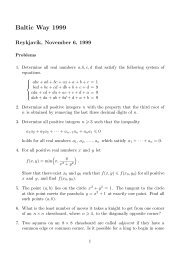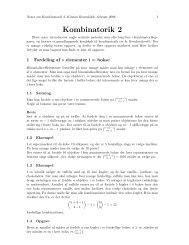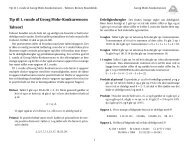You also want an ePaper? Increase the reach of your titles
YUMPU automatically turns print PDFs into web optimized ePapers that Google loves.
<strong>Problems</strong> for the Team Competition Baltic Way 1998<br />
4 1<br />
2<br />
Warsaw, November 8, 1998<br />
hours. 5 points per problem.<br />
1. Find all functions f of two variables, whose arguments x, y and values f(x, y) are positive integers,<br />
satisfying the following conditions (for all positive integers x and y):<br />
f(x, x) = x,<br />
f(x, y) = f(y, x),<br />
(x + y)f(x, y) = yf(x, x+y).<br />
2. A triple (a, b, c) of positive integers is called quasi-Pythagorean if there exists a triangle with<br />
lengths of the sides a, b, c and the angle opposite to the side c equal to 120 ◦ . Prove that if (a, b, c)<br />
is a quasi-Pythagorean triple then c has a prime divisor bigger than 5.<br />
3. Find all pairs of positive integers x, y which satisfy the equation 2x 2 + 5y 2 = 11(xy − 11).<br />
4. Let P be a polynomial with integer coefficients. Suppose that for n = 1, 2, 3, . . . , 1998 the number<br />
P (n) is a three-digit positive integer. Prove that the polynomial P has no integer roots.<br />
5. Let a be an odd digit and b an even digit. Prove that for every positive integer n there exists<br />
a positive integer, divisible by 2 n , whose decimal representation contains no digits other than<br />
a and b.<br />
6. Let P be a polynomial of degree 6 and let a, b be real numbers such that 0 < a < b. Suppose<br />
that P (a) = P (−a), P (b) = P (−b), P ′ (0) = 0. Prove that P (x) = P (−x) for all real x.<br />
7. Let R be the set of all real numbers. Find all functions f: R → R satisfying for all x, y ∈ R the<br />
equation f(x) + f(y) = f(f(x)f(y)).<br />
8. Let Pk(x) = 1 + x + x2 + · · · + xk−1 . Show that<br />
n�<br />
� �<br />
n<br />
Pk(x) = 2<br />
k<br />
n−1 �1 + x�<br />
Pn<br />
2<br />
k=1<br />
for every real number x and every positive integer n.<br />
9. Let the numbers α, β satisfy 0 < α < β < π/2 and let γ and δ be the numbers defined by the<br />
conditions:<br />
(i) 0 < γ < π/2, and tan γ is the arithmetic mean of tan α and tan β;<br />
(ii) 0 < δ < π/2, and<br />
Prove that γ < δ.<br />
1<br />
cos δ<br />
is the arithmetic mean of<br />
1<br />
cos α and<br />
1<br />
cos β .<br />
10. Let n ≥ 4 be an even integer. A regular n-gon and a regular (n−1)-gon are inscribed into the unit<br />
circle. For each vertex of the n-gon consider the distance from this vertex to the nearest vertex of<br />
the (n−1)-gon, measured along the circumference. Let S be the sum of these n distances. Prove<br />
that S depends only on n, and not on the relative position of the two polygons.<br />
1
11. Let a, b, c be the lengths of the sides of a triangle. Let R denote its circumradius. Prove that<br />
a<br />
R ≥<br />
2 + b2 2 √ 2a2 + 2b2 .<br />
− c2 When does equality hold ?<br />
12. In a triangle ABC, � BAC = 90 ◦ . Point D lies on the side BC and satisfies � BDA = 2� BAD.<br />
Prove that<br />
1<br />
AD<br />
� �<br />
1 1 1<br />
= + .<br />
2 BD CD<br />
13. In a convex pentagon ABCDE, the sides AE and BC are parallel and � ADE = � BDC. The<br />
diagonals AC and BE intersect in P . Prove that � EAD = � BDP and � CBD = � ADP .<br />
14. Given triangle ABC with AB < AC. The line passing through B and parallel to AC meets the<br />
external angle bisector of � BAC at D. The line passing through C and parallel to AB meets<br />
this bisector at E. Point F lies on the side AC and satisfies the equality F C = AB. Prove that<br />
DF = F E.<br />
15. Given acute triangle ABC. Point D is the foot of the perpendicular from A to BC. Point E lies<br />
on the segment AD and satisfies the equation<br />
AE CD<br />
=<br />
ED DB .<br />
Point F is the foot of the perpendicular from D to BE. Prove that � AF C = 90 ◦ .<br />
16. Is it possible to cover a 13 × 13 chessboard with fourty-two pieces of dimensions 4 × 1 such that<br />
only the central field of the chessboard remains uncovered ? (We assume that each piece covers<br />
exactly four fields of the chessboard.)<br />
17. Let n and k be positive integers. There are nk objects (of the same size) and k boxes, each of<br />
which can hold n objects. Each object is coloured in one of k different colours. Show that the<br />
objects can be packed in the boxes so that each box holds objects of at most two colours.<br />
18. Determine all positive integers n for which there exists a set S with the following properties:<br />
(i) S consists of n positive integers, all smaller than 2 n−1 ;<br />
(ii) for any two distinct subsets A and B of S, the sum of the elements of A is different from the<br />
sum of the elements of B.<br />
19. Consider a ping-pong match between two teams, each consisting of 1000 players. Each player<br />
played against each player of the other team exactly once (there are no draws in ping-pong).<br />
Prove that there exist ten players, all from the same team, such that every member of the other<br />
team has lost his game against at least one of those ten players.<br />
20. We say that some positive integer m covers the number 1998, if 1, 9, 9, 8 appear in this order as<br />
digits of m. (For instance 1998 is covered by 215993698 but not by 213326798.) Let k(n) be the<br />
number of positive integers that cover 1998 and have exactly n digits (n ≥ 5), all different from<br />
0. What is the remainder of k(n) in division by 8?<br />
2


